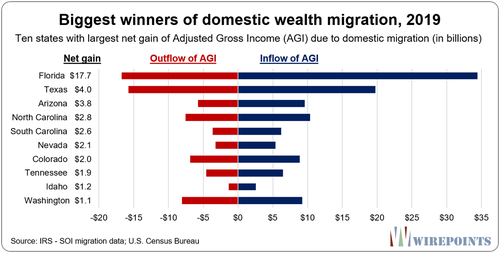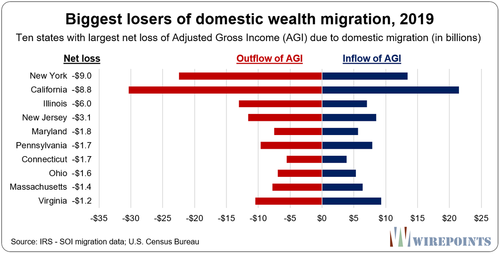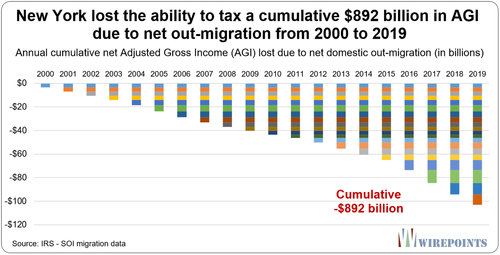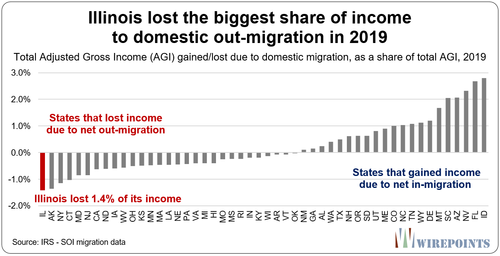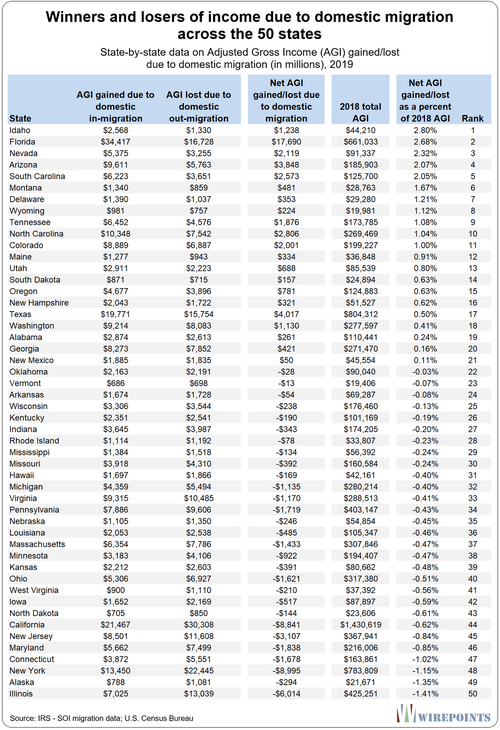New IRS Data Reveals Which States Won (And Lost) In The Battle For People & Their Wealth
Authored by Ted Dabrowski and John Klingner via Wirepoints.org,
Every year, states across the country compete with each other for people and their wealth as millions of Americans move between states. The stakes are large. A growing population for the winners means an increasing tax base, economic growth and investment. For the biggest losers, it means more difficulties in paying down debts, higher taxes and fewer investments for the future.
The nation’s most-recent winners of migration from other states are Florida and Idaho. Florida, the nation’s perennial winner, gained the most people and income overall in 2019, while Idaho gained the most of both on a percentage basis.
On the other end of the competition are states that have become perennial losers. States like California, New York, Illinois and New Jersey once again experienced some of the nation’s biggest losses of both residents and their money.
Those findings are based on a Wirepoints’ analysis of the latest 2019 domestic migration data provided by the Internal Revenue Service. The IRS reviews tax returns annually to track when and where people move. It also aggregates the ages, income brackets and adjusted gross incomes of filers.
Winners and losers
The Sunshine State attracted over $34.4 billion in Adjusted Gross Income (AGI) from 558,096 new residents (tax filers and their dependents) that moved into Florida in 2019. On the flip side, Florida lost $15.6 billion in AGI from 431,307 people who left. Overall, Florida came out ahead with 126,789 net new people and $17.7 billion in net new taxable income.
That’s a total gain of about 2.7 percent of the state’s total 2018 AGI ($661 billion).
Texas was the runner up with a net income gain of $4.0 billion, followed by Arizona with $3.8 billion. North and South Carolina rounded out the top five with net gains of $2.8 billion and $2.6 billion, respectively.
On the losing side, New York suffered the worst outflow of money of any state in 2019. The Empire State lost a net $9 billion in income, or more than 1.15 percent of its 2018 AGI, while a net of nearly 153,000 residents moved out.
California was next, losing a net $8.8 billion and 165,000 people. Illinois was third with a net loss of $6.0 billion and 82,000 people. New Jersey and Maryland were in 4th and 5th place, with $3.1 and $1.8 billion in income losses, respectively.
Tables with each state’s ranking in migration gains/losses are provided below.
The cumulative impact of income losses and gains
The problem with chronic outflows, like in the case of New York, is that one year’s losses don’t only affect the tax base the year they leave, but they also hurt all subsequent years. The losses pile up on top of each other, year after year. And when a state loses income to other states for 19 straight years, the numbers add up.
In 2019 alone, New York would have had nearly $103 billion more in AGI to tax had it not been for the state’s string of yearly migration losses.
And when the state’s AGI losses are accumulated from 2000 to 2019, it totals $892 billion in cumulative lost income that could have been taxed over the entire period.
The opposite is true for migration winners like Florida. Gains in people and income pile on top of each other each year, building an ever-growing tax base. In 2019 alone, the state’s tax base was some $173 billion higher due to the 19-year string of positive income gains from net in-migration.
Even though Florida doesn’t tax incomes, Wirepoints also added up Florida’s cumulative AGI to make an apples-to-apples comparison with New York. When the Sunshine State’s AGI gains are accumulated from 2000 to 2019, it totals $1.4 trillion in income that could have been taxed over the entire period.
The competition for people matters
Illinois’ own experience with out-migration shows just how damaging being an “exit” state can be.
Based on a percentage of total income, Illinois ranked worst nationally for income losses in 2019. Illinois lost 1.41 percent of its 2018 AGI. Alaska and New York ranked second and third, with losses of 1.35 percent and 1.15 percent of their total incomes, respectively.
In contrast, Idaho was the nation’s big winner on a percentage basis in 2019, gaining 2.8 percent of its 2018 AGI base. The nation’s top five were rounded out by Florida, Nevada, Arizona and South Carolina.
Illinois’ $6.0 billion AGI loss in 2019 wasn’t just a one-time thing. Wirepoints’ analysis found that, like New York, the state has netted annual losses of both resident and AGI every single year since at least 2000.
Florida’s gains and Illinois’ losses are a clear reminder that states are constantly competing for people, businesses and a growing tax base.
The prize for winning is big, but the price for losing may be even bigger.
Read more about migration and population changes across the nation:
Appendix
Tyler Durden
Fri, 06/04/2021 – 12:41
via ZeroHedge News https://ift.tt/3wP5xgK Tyler Durden
